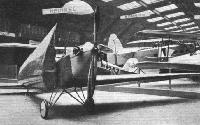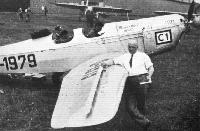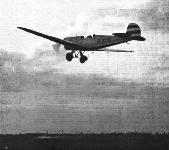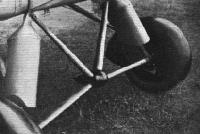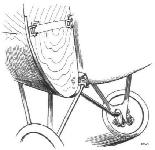
Варианты
- Messerschmitt - BFW M.23 / M.27 - 1928 - Германия
- ICAR - Universal - 1934 - Румыния
Messerschmitt M.23
M.23, разработанный В.Мессершмиттом, стал в начале 1930-х годов популярным легким самолетом. Это был низкоплан с консольным крылом, в основном деревянной конструкции с частично полотняной обшивкой. Две открытые кабины располагались тандемом в фюзеляже, обшитом фанерой. Управление полностью дублировано. Оперение - традиционное, шасси не- убираемое с хвостовой лыжной опорой.
Базовый вариант обозначался M.23a, на него ставили 2-цилиндровый мотор Scorpion мощностью 34 л.с. или звездообразный Salmson A.D.9 в 40 л. с.
Вариант M.23b в целом близок M.23a, но его конструкция усилена под установку более мощных моторов, включая Siemens Sh.13 мощностью 68 л. с., Armstrong Siddeley мощностью 81 л.с. и Cirrus Hermes III мощностью 110 л. с.
ТАКТИКО-ТЕХНИЧЕСКИЕ ХАРАКТЕРИСТИКИ
Messerschmitt M.23b
Тип: двухместный легкий моноплан
Силовая установка: один мотор жидкостного охлаждения Cirrus Hermes III мощностью 110 л. с.
Летные характеристики: максимальная скорость 175 км/ч; практический потолок 5800 м; дальность 670 км
Масса: пустого 320 кг; максимальная взлетная 570 кг
Размеры: размах крыла 11,80 м; длина 6,65 м; высота 2,30 м; площадь крыла 14,40 м2
Описание:
- Messerschmitt M.23
- Messerschmitt. От M.25 до M.28
- Flight, October 1928
THE BERLIN AERO SHOW 1928 - Flight, June 1929
OLYMPIA AERO SHOW 1929 - Flight, March 1930
THE B.F.W. M.23
Фотографии
-
Flight 1929-10 / Flight Advertisements
MESSERSCHMITT BFW-M 23 WITH THE VICTORIOUS SIEMENS SH 13, 72/80 H.P.
-
Flight 1930-03 / Flight
THE B.F.W. MESSERSCHMITT M.23b: Fitted with Siemens SH 13 70 h.p. engine, this machine secured first place in the International Light 'Plane Tour of Europe last year
-
Flight 1928-10 / Flight
The B F.W. M23 low-wing monoplane with 20 h.p. Mercedes engine. Note the starboard wing carried on the side of the fuselage for transport.
-
Flight 1929-08 / Flight
Регистрационный номер: D-1668, D-1675 THE FOLDING TEST AT ORLY: (5) Two of the German B.F.W. monoplanes, some of which were fitted with Genet engines and others with Siemens and Halske engines.
-
Flight 1929-08 / Flight
THE FOLDING TEST AT ORLY: (1) Avia Antelope (Walter engine) with German B.F.W. in the rear
Другие самолёты на фотографии: Avia BH-9 / BH-10 / BH-11 / BH-12 / BH-16 - Чехословакия - 1923
-
Flight 1929-08 / Flight
PETROL TEST AT THE ORLY MEETING: (4) Two B.F.W. monoplanes
-
Flight 1929-08 / Flight
PETROL TEST AT THE ORLY MEETING: (2) The Genet-engined B.F.W. and the Aero 34 (Walter)
Другие самолёты на фотографии: Aero A.34 Kos - Чехословакия - 1929
-
Flight 1930-03 / Flight
THE B.F.W. MESSERSCHMITT M.23a: This version is fitted with a 40-h.p. Salmson AD 9 engine
-
Flight 1930-03 / Flight
THE B.F.W. MESSERSCHMITT M.23b: Except for the fact that it is fitted with the "Cirrus" engine, this is similar to the machine flown to victory in the Tour of Europe by Morzik last year
-
Flight 1929-10 / Flight Advertisements
MESSERSCHMITT BFW-M 23 WITH THE CIRRUS M.III, 88/95 H.P.
-
Мировая Авиация 188
Как видно на этой фотографии M.23a, самолет отличало превосходное крыло необычно большого размаха, который составлял 11,83 м.
-
Flight 1929-10 / Flight Advertisements
MESSERSCHMITT BFW-M 23 WITH THE ARMSTRONG SIDDELEY GENET, 81/86 H.P. (FOLDED).
-
Flight 1930-07 / Flight
LOW-WING MONOPLANE: A BFW with BMW X radial engine.
-
Мировая Авиация 188
На M.23b допускалась установка более мощных, чем на варианте M.23a, моторов. Самолет мог иметь поплавковое шасси.
-
Flight 1933-08 / Flight
Регистрационный номер: D-1888 -
Air-Britain Archive 1986-02
Регистрационный номер: YR-AAP [2] YR-AAP on also carries an ICAR symbol but looks like a licence-built BFW M.23. It,carries a spare prop and appears to be on a tropical tour. Any further information on either aircraft or their itineraries would be appreciated.
YR-AAP was a Messerschmitt M23b licence-built by ICAR with a Seimens-Halske SH13B engine. With two others it attempted to fly from Bucharest to Cape Town in 1933 but the flight had to be abandoned due to adverse weather at Malakal in Sudan. The pilots involved were M.Pantazi, G.Davidescu, A.Cernescu, P.Ivanovici, M.Manolescu and mechanic D.Ploesteanu. Presumably the photograph was taken during the attempt. -
Air Enthusiast 1996-05 / D.Bernad - The First Twenty Five Years. Romanian Aircraft Production 1911-1935
Регистрационный номер: YR-AAP [2] One of three M.23bis that took part in a long-ranging African tour. Note that a spare propeller is carried on the rear fuselage.
-
Air Enthusiast 1996-05 / D.Bernad - The First Twenty Five Years. Romanian Aircraft Production 1911-1935
Регистрационный номер: YR-ADF Fine in flight study of ICAR M.23b YR-ADF. The factory emblem was applied both on the fin bottom and engine cowling.
-
Flight 1930-07 / Flight
Регистрационный номер: D-1890 ONE OF THE BFW MONOPLANES: This particular machine is fitted with a Siemens engine, although according to the original list its racing number corresponds to an Argus.
-
Мировая Авиация 188
Регистрационный номер: D-1924 Вариант M.23C образца 1930 года получил закрытую кабину и мотор Argus As-8R.
-
Flight 1930-07 / Flight
STYLE IN COUPE TOPS: One of the BFW Machines
-
Flight 1930-07 / Flight
SOME "RUNDFLUG NOSES": 1, a BFW M.23 with Siemens-Halske engine. Note Coupe Top.
-
Flight 1931-08 / Flight
Регистрационный номер: D-1979 [2] NOT HANDLEY PAGE AND NOT LACHMANN: The Messerschmitt machine flown by Croneiss was fitted with an auxiliary aerofoil above the main wing, placed at approximately one-third chord length back from the leading edge.
-
Мировая Авиация 188
Регистрационный номер: D-2461 Максимальная скорость самолета M.27b составляла 200 км/ч, дальность полета - 700 км.
-
Flight 1931-08 / Flight
Регистрационный номер: D-1979 [2] A NEW TYPE: The Messerschmitt M. 27 flown by Theo Croneiss.
-
Flight 1931-08 / Flight
A NEW TYPE IN THE COMPETITION: The BFW-Messerschmitt 27 flown by Theo Croneiss was fitted with "spats."
-
Flight 1931-08 / Flight
A NEW TYPE IN THE COMPETITION: The BFW-Messerschmitt 27. The control cables could be inspected through the flap doors near the tail.
-
Flight 1933-08 / Flight
AN OLD TIMER: Arthur Martens, who won fame in the early days as a "wizard" glider pilot, in his Messerschmitt M.27 b.
-
Flight 1928-10 / Flight
The wings of the B.F.W. M.23 are dismantled by undoing three catches, and are then carried on the sides of the fuselage.
-
Flight 1929-07 / Flight
On the B.F.W. M.23 a split undercarriage is used, with the bent axles hinged to a pyramid from the bottom of the fuselage.
- Фотографии


